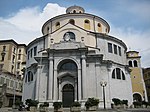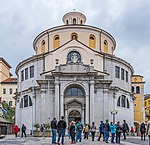Rijeka Tunnel

The Rijeka Tunnel (Croatian: Riječki tunel), also called TunelRi, is a pedestrian tunnel located in the city centre of Rijeka, Croatia. The tunnel spans 350 metres (1,150 ft) from St. Vitus Cathedral to Dolac Primary School in Old Town. It was originally built from 1939 to 1942 by the Italian military in order to protect civilians from Allied aerial bombings during World War II. In several places along the tunnel, one can still see the original "Riservato all U.N.P.A." ("Reserved for the Anti-aircraft Corps") signs.After being closed for 75 years, the tunnel was remodeled and opened to the public in 2017, serving as a tourist attraction and public passage. The tunnel has no entrance fee and is open for public access every day from 9 a.m. to 5 p.m.
Excerpt from the Wikipedia article Rijeka Tunnel (License: CC BY-SA 3.0, Authors, Images).Rijeka Tunnel
Grivica, Grad Rijeka Mjesni odbor Školjić-Stari grad (Rijeka)
Geographical coordinates (GPS) Address Nearby Places Show on map
Geographical coordinates (GPS)
| Latitude | Longitude |
|---|---|
| N 45.327734 ° | E 14.444192 ° |
Address
Katedrala sv. Vida
Grivica 11
52100 Grad Rijeka, Mjesni odbor Školjić-Stari grad (Rijeka)
Croatia
Open on Google Maps








